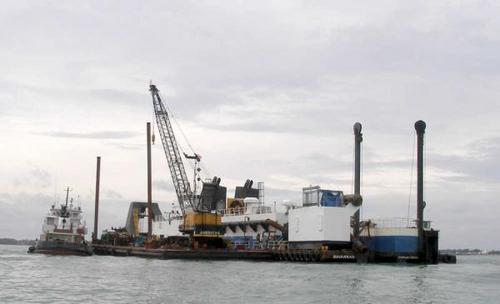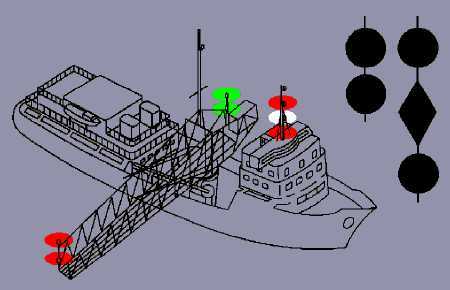
The saga of our 450 year old shipping channel continues as dredging of the St. Augustine Inlet began last week. In an effort to both maintain safe bathymetry (enough deep water) and a big, wide beach, sand is pumped from the bottom of the inlet and onto St. Augustine Beach. LAMP is helping to guard our maritime history and ensure we don’t lose anything to this important project.
This project, the third in a series of dredging operations scheduled over a 50 year span, will deposit 2.1 million cubic yards of sand on the beach around the pier and adjacent areas. That is the equivelent to 210,000 dump truck loads of sand! The most efficient way to move the sand is to pump it through pipes from the dredge to the spoil site. A 240′ dredge, the Savannah, prowls back and forth across the inlet with its long snout on the bottom. At the end of this giant steel proboscis is a rotating cutterhead, made from hardened teeth that chew up the seafloor and allow it to be sucked away into a waiting pipe. From here, it is moved through the dredge by a giant pump and then off the dredge via 24″ pipe. In our case the material is pumped about 3.8 miles down the beach.

The dredge Savannah. (Image courtesy of the St. Augustine Record)
I will take a moment to caution folks here, so listen up! The dredge pipe can be a hazard to swimmers on the beach, surfers, and boaters. If you are on the beach and see large orange balls floating int he surf, STAY AWAY FROM THESE. under them is the submerged iron pipe and you don’t want to get knocked into it by a wave. It is much harder than you.
Similarly, the dredge pipeline will, at times, have to cross the inlet channel. For boaters this means one thing: LEARN HOW TO PASS IT SAFELY. There is a right side and a wrong side. On the dredge itself during the day you will see, over the wheelhouse, ball-diamond-ball shapes in a vertical line. At night this will be replaced with a red over white over red light. This means “I am engaged in operations which restrict my ability to maneuver.” This vessel is called a RAM (Restricted in Ability to Maneuver) and unless you are another RAM or broken down (a ‘NUC’, Not Under Command), the you are the give-way vessel. So, how do you give-way correctly and safely?
On the danger side you will see, during the daylight hours, a ball over ball shape (at night red over red) and this means DO NOT PASS ON THIS SIDE. On the safe side you will see a diamond over diamond (green over green at night) PASS ON THIS SIDE as “diamonds are a girl’s best friend”, right? (33 CFR 84.07+ 33 CFR 83.27)

An illuminated dredge. Note the double green lights on the ‘safe’ side of the dredge.
The dredge line will be floating out behind the dredge like a tail. It will be floating on big steel floats and during the daylight hours will usually be easy to see. However, in restricted visibility and at night, the line will be lit with yellow flashing lights (50-70 flashes per minute.) Do not motor between these unless you wish to cave in your boat on a steel pipe. Where the dredge line submerges, to cross the channel on the bottom, there will be a red over red light. If there is an area of the dredge line that has specifically been submerged for safe passage and then re-emerges on the surface, there will be a pair of these red light configurations to indicate the safe place to cross. Think of the bridges around here, the channel is marked on them with a red light on either side, with an added green or red light above for height marking. (33 CFR 88.15) There are no provisions for dayshapes on floating dredge pipelines so maintain a proper lookout and proceed at a safe speed.
If in restricted visibility provisions are established for sound signals thusly “A vessel not under command, a vessel restricted in her ability to maneuver, a vessel constrained by her draft, a sailing vessel, a vessel engaged in fishing and a vessel engaged in towing or pushing another vessel shall, instead of the signals prescribed in paragraph (a) or (b) of this Rule, sound at intervals of not more than 2 minutes three blasts in succession, namely one prolonged followed by two short blasts.” Simply, if you hear a bunch of blasts aread of you, slow to bare steerageway and keep an extra sharp lookout. If equipped with radar, it must be turned on and monitored. You may see a large blob in the inlet representing the dredge ship.
Be aware too, that you should treat the dredge crew with respect and, no matter how curious you are, don’t get close to the dredge. It may seem like it moves slow, but it stops slow too and will be guaranteed to weigh more than most other traffic here in town. Be courteous when passing and slow down. While the big barges don’t roll much in your wake, there might be workmen loading and unloading from smaller vessels ( a dredge is never alone) and you don’t want to upset anything they’re doing. Remember that you are responsible for any damage you wake causes so transit the inlet slowly around the equipment for you safety and theirs. If you are unsure of where to pass, the Savannah monitors VHF channels 13 and 16, ask them questions and they will be happy to keep you on the safe side. Those guys are out there pumping all day and night, lets help make their job easy and they will be out of our way sooner.
But back to the beach for now. The end of the dredge line emerges from the sea not far from the main beach access at Anastasia State Park. From here the line will travel south as the sand berm forms and is pushed into flat, wide beach by a pride of bulldozers. This area is usually staked out by an orange fence. Do not cross the fence as this is a restricted and dangerous area for many reasons. As the sand comes out and is spread, it gets washed by the high tides and rain. It is at this point that LAMP heads out to survey for historic artifacts or shipwreck debris.

LAMP Intern Brian McNamara recording an artifact on the St. Augustine Beach Renourishment Project.
The area of the dredging has been surveyed and ‘cleared’ for dredging by archaeologists, this is required by law but you never know what you might find when messing with the sea floor. Artifacts may be uncovered which have been separated from shipwrecks but can still tell us about ships that have wrecked here. Similarly, since the dredge effectively makes a depression in the seabed, sand from elsewhere naturally wants to flow into this area. As a result, the area around the dredged channel can deflate slightly and expose buried wrecks. Our oldest wrecks here in the First Coast are the most deeply buried. Centuries of storms, decay, and the natural rhythms of the ocean essentially suck wrecks into the sand. They can be hard to find if there is not much left, especially if there is little magnetic signature. So, this means that while archaeological survey is fairly comprehensive it can rarely give a difinitive answer to whether or not all cultural materials have been located. Think about our technology too, magnetometers and sonars of today will pale in comparison to instruments of the future. Use your wildest imagination and that is what we will have. Who would think that we could have ‘seen’ the sea floor with acoustics when 100 years ago most people still rode horses to get around?! And so the story goes on. We use our best technology and expertise to try and protect our heritage the best we can but when it comes down to it, simply walking over the dredge spoil may help save what otherwise might get lost.
Artifacts what wash up on the beach are immediately in peril. For one, they can dry out and begin a process of destructive decay. Iron blows up in a rusty glob and dissapears as a crusty stain. Wood checks, cracks, and splits into an ugly resemblance of its former shape. If you find what you think is an artifact, then mark its location as best you can (using a nearby landmark, take a photograph if you can, or even a gps point) and let us know. Just as a reminder, artifact collecting on the beach is illegal without a permit. While metal detecting for modern debris (coins, rings, etc.) is legal on county beaches, historic artifacts may be part of an archaeological site. Even dredge spoil may contain clusters of artifacts which have come from a site. This relocated site is still a site and therefore is protected. Taking or removing artifacts from archaeological sites is a third degree felony. We don’t want to scare anybody by saying this but it is the existing law and is there to protect our shared heritage. Artifacts are sonetimes our only link to a chapter of the past, a chapter that may have never been written about but holds important significance. While many artifacts found by archaeologists do go on shelves, the shelves they go on are public and are publicly available. This information is ours, the data is accessible as long as it doesn’t threaten the integrity of the site or condition of the artifact. Artifacts in public repositories are held in perpetuity, just as evidence from crime scenes involving homicide or other serious violations is held. How would we ever solve cold cases were it thrown away or forgotten? Victims may get satisfaction from this data, the wrongfully accused may gain freedom, all from a minicule portion of a larger collection. For reasons like this, we meticulously keep and protect data.

This concretion is from an old metal cauldron. Unlike the cast iron cauldrons we have excavated from the Storm Wreck Site, this large pot would have been made from sheet copper or tin and had a reinforcing band riveted around it. This concreted cast holds remnant details of the reinforcing band.
So, we are out there and looking, if you see us behind the fence call us over if you have questions, we’ll be happy to answer them and show you what we’ve found. Drop by the Lighthouse Museum too, to see what we’re doing over here, its pretty fun! We have behind-the-scenes tours to get into the nitty gritty of maritime archaeology which are well worth the few extra bucks for your ticket. And not, but least, visit our webpage and see what we’re doing. We are always expanding it and trying to make as much of our research as possible available, so keep coming back.
Be safe out there!

